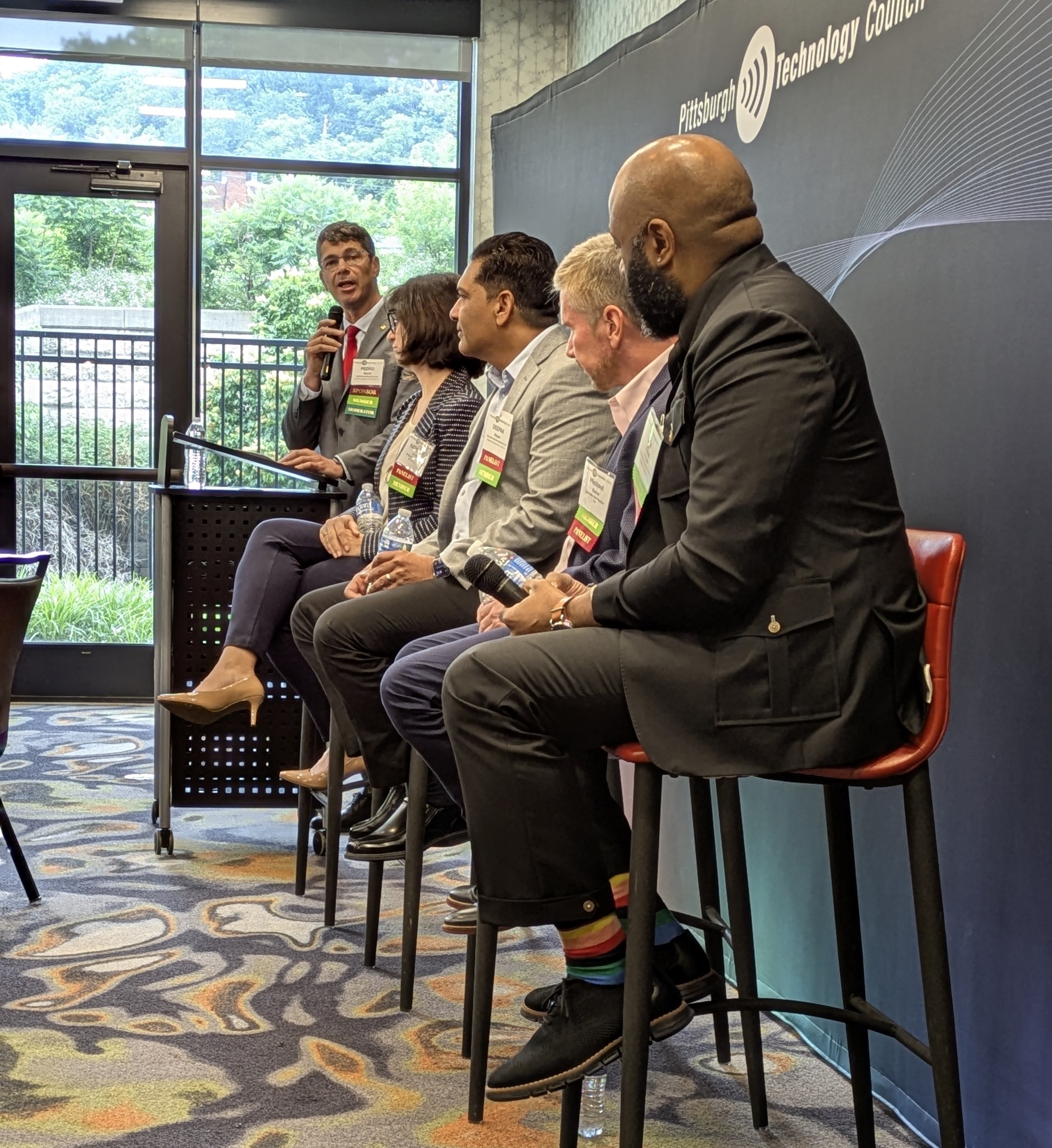CIO Insights: The Evolving Role of IT Leadership in an AI-Powered Enterprise
By Sheena Carroll
 As artificial intelligence continues to evolve, organizations across industries are wrestling with how to harness its potential while managing risk, ensuring trust, and navigating cultural transformation. On June 16, the Pittsburgh Technology Council hosted a panel discussion as part of their CIO Insights series, featuring tech leaders – Mike Keslar (Divisional CIO and President, BNY Pennsylvania), Kathleen Lovett (VP and CIO - Supply Chain, VSP Vision), Deepak Nayyar (Executive VP and CIO, Pittsburgh International Airport), Stan Waddell (VP of IT and CIO, Carnegie Mellon University) and moderator Pedro Barelli (VP of Consulting Services, CGI) – to shed light on the strategic, operational, and cultural dimensions of implementing AI at-scale.
As artificial intelligence continues to evolve, organizations across industries are wrestling with how to harness its potential while managing risk, ensuring trust, and navigating cultural transformation. On June 16, the Pittsburgh Technology Council hosted a panel discussion as part of their CIO Insights series, featuring tech leaders – Mike Keslar (Divisional CIO and President, BNY Pennsylvania), Kathleen Lovett (VP and CIO - Supply Chain, VSP Vision), Deepak Nayyar (Executive VP and CIO, Pittsburgh International Airport), Stan Waddell (VP of IT and CIO, Carnegie Mellon University) and moderator Pedro Barelli (VP of Consulting Services, CGI) – to shed light on the strategic, operational, and cultural dimensions of implementing AI at-scale.
A Measured Approach to AI Implementation
The panelists emphasized a disciplined, value-driven approach to AI deployment. A recurring theme was the importance of focusing only on projects with a high return potential. Efficiency, customer understanding, and strategic transformation were the guiding metrics.
To manage this, organizations are employing a dual approach: bottom-up innovation combined with top-down governance. While individual business units are encouraged to develop their own AI solutions, some projects are built on a centralized AI platform, such as BNY’s Eliza (named about the wife of company founder Alexander Hamilton). Keslar noted that all employees at the company are being trained and tested on – with some already using daily – the Eliza platform.
Pittsburgh International Airport has started using predictive models for maintenance and repairs, which decreases overall costs and keeps their equipment such as elevators in regular, good-working shape. VSP Vision has been focused on using AI for retail strategy, while Carnegie Mellon has been targeting all of their domains – pedagogy, research, and administration.
Building and Maintaining Client Trust
Client trust emerged as a central concern, especially for financial institutions like BNY Mellon. As the world’s largest custodian of assets, the company takes a cautious approach to moving AI applications into production. Many AI initiatives are client-facing but designed to add value without increasing risk.
Data, Data, Data
AI is not just transforming operations; it's reshaping how software is developed and delivered. Panelists noted that traditional intake methods—such as gathering business requirements through whiteboarding sessions—are being replaced or augmented by data-driven insights. AI can now identify functionality needs and process flows based on actual usage data and outlier analysis.
One of the challenges facing companies today is that their data is not “AI-ready” – Waddell pointed out that some of Carnegie Mellon University’s data was not organized with the intention to help machine learning, making it more difficult to use.
“AI is nothing without data,” said Keslar.
Nayyar noted that the Pittsburgh International Airport is building tech to ensure that their data is primed for AI modeling.
Addressing Workforce Concerns and Encouraging Adoption
The human element of AI implementation cannot be overlooked. Fear of job loss and uncertainty about how to engage with new tools are major hurdles. Several panelists emphasized the need to reassure employees that AI is designed to complement, not replace, human workers.
Education and transparency are key. Panelists shared that many employees were hesitant to try AI tools like ChatGPT simply because they didn’t understand how to use them. Simple encouragement, combined with relatable examples (like using AI to plan a cross-country road trip), has helped demystify the technology.
Importantly, some leaders are now openly acknowledging that AI will impact certain roles. Being honest about potential job changes, while simultaneously encouraging upskilling and early adoption, has proven to be a credible and constructive approach.
AI Requires Balance
The panel made it clear that successful AI adoption is not just a technical challenge, but a strategic and cultural one. Balancing experimentation with governance, innovation with client trust, and automation with human empathy is critical.
Organizations looking to follow in their footsteps should focus on:
- Prioritizing high impact use cases for their industry
- Building client confidence through transparency and outcomes
- Embracing modern development practices
- Investing in workforce education and engagement
AI is not a silver bullet, but with a thoughtful, deliberate approach, it can be a powerful force for efficiency, insight, and transformation.